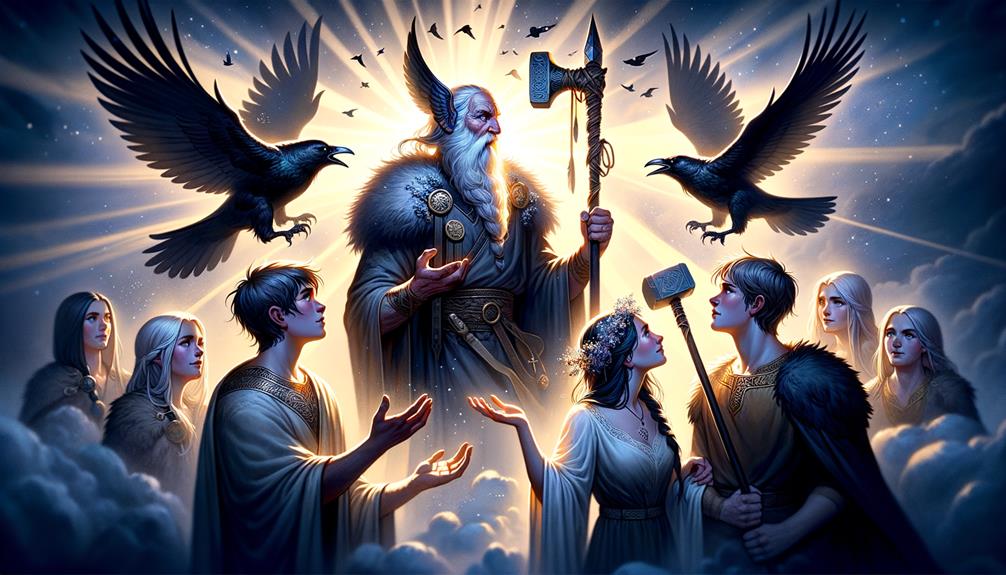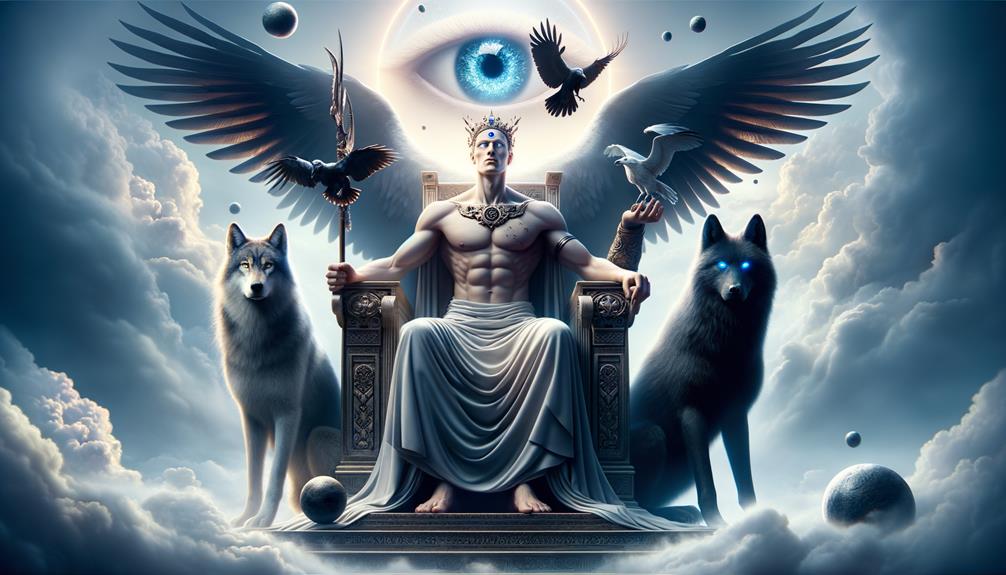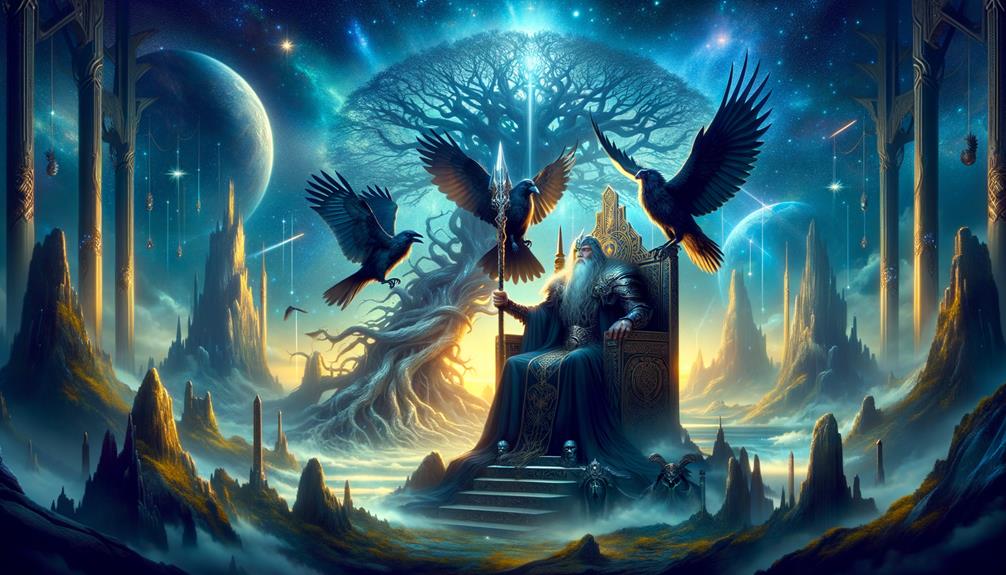In Norse mythology, Odin is a top dog. He’s in charge of the spiritual world and oversees war, wisdom, and poetry. His names paint a picture of a divine wildness, and he’s often shown as the leader of the entranced. He can change his form and often appears in stories on a knowledge-seeking mission, even giving up an eye for wisdom. He’s a fortune teller of sorts, shaping futures with his wives and kids, who each carry his influence. His iconic items, like the Spear Gungnir and his eight-legged horse Sleipnir, underline his control and his ability to travel between worlds. If you dig a little deeper, you’ll find out even more about Odin’s mythological depth.
Understanding Odins Etymology
When you look at the origins of Odin’s name, you see some interesting links to medieval Germanic monikers like Wōden and Wuotan. These names suggest a divine aspect of possession or inspiration. In the context of Norse mythology, Odin, or Óðinn, embodies wisdom and frenzy. These traits reflect the historical implications tied to his name.
The term Wōden, which has its roots in the Proto-Germanic *Wōðanaz, can be interpreted as the ‘lord of frenzy‘ or ‘the one leading the possessed.’ This interpretation highlights Odin’s control over the realms of possession and inspiration. The term *Wōðanaz is closely tied to the adjective *wōðaz, which means ‘possessed’ or ‘delirious,’ further emphasizing Odin’s mysterious and elusive nature. These attributes are key aspects of Norse mythology and cultural symbolism.
The philologist, Jan de Vries, proposed that Óðr could be the base for Óðinn, indicating a close link between Odin and Óðr within Norse mythology. This theory adds to the intricate layers of meaning and symbolism intertwined with Odin’s name. By exploring the origins of Odin’s name, we get a more profound understanding of his role as a Norse god of wisdom, frenzy, and divine inspiration.
Exploring Odins Family and Relationships

Let’s take a closer look at Odin’s family tree, it’s really interesting to see how his relationships with his wife Frigg, his other wives, and his many children like Thor, Balder, Vidarr, and Bragi, highlight his different roles in Norse mythology. Frigg, the main wife of Odin, is a goddess associated with love, marriage, and destiny. Her wisdom and influence can be seen in Odin’s choices, and her motherly role to the gods shows her nurturing side.
Odin’s other wives, such as Rindr, Grid, and Jörd, who are each mother to one of Odin’s sons, represent power, fertility, and the earth. They’re responsible for giving birth to gods who are associated with war, poetry, revenge, and protection. So, each son of Odin represents a different part of his influence. For example, Thor, the god of thunder and war, carries a powerful hammer that represents Odin’s spear, while Bragi, the god of poetry, signifies Odin’s connection with ravens and mead.
Odin’s complex family tree mirrors the intricate relationships within the Norse pantheon. The gods interact with each other in ways that mix their traits and roles, forming a rich and intricate story that characterizes Norse mythology.
Roles of Odin in Norse Mythology

Odin’s family tree is a complex web that provides a sneak peek into his multifaceted influence. But it’s his roles in Norse mythology that really highlight his importance as the Allfather. Odin is the Norse god of war, wisdom, and poetry, which means his impact touches every aspect of Norse existence, both in life and in the afterlife. He’s in charge of Valhalla, where fallen heroes gather to feast and get ready for the last battle of Ragnarök. His eagerness to gain knowledge is so intense that he willingly gave up his own eye in exchange for wisdom.
Also, Odin has the cool ability to change his shape. He often wanders around in various forms, with his two loyal ravens, Huginn and Muninn, by his side. They act as his eyes and ears in the world. He’s also a big fan of poetry. This was proven when he swiped the Mead of Poetry, showing just how much he wants wisdom and understanding.
But Odin’s roles in Norse mythology aren’t just confined to these. He has a hand in shaping events, making prophecies, and determining the destinies of gods and humans. This makes him an intriguing character in mythology, cementing his position as the Allfather. His roles paint a picture of a god who’s not only mighty but also values wisdom, conversation, and planning for what lies ahead.
Symbols and Artifacts Associated With Odin
Let’s chat about some of the symbols and things that remind us of Odin, a key figure in Norse mythology, to better understand his influence and power. Take Odin’s spear, Gungnir, for example. This isn’t just any weapon; it’s a testament to his authority and his unmatched skill in battle. One could say it’s a badge of his tireless drive for victory.
Odin’s horse, Sleipnir, is another fascinating symbol. This isn’t just any horse; it has eight legs! It highlights Odin’s unique ability to journey between worlds. It’s a reminder that Odin’s reach was far and wide across the Norse realm.
Then there’s the Valknut, a design made up of three triangles intertwined. This symbol has strong connections to Odin, representing his roles as a god of war, death, and wisdom.
Next, we have the Triple Horn of Odin, which is a visual sign of Odin’s control over mead and wisdom. It gives us a glimpse into his intellectual prowess.
The Valkyrie, fierce female spirits serving Odin in battle, reflect his power in choosing the bravest warriors for his heavenly hall, Valhalla.
Lastly, let’s not forget Hugin and Munin, Odin’s ravens. These birds stand for his wisdom and knowledge. They fly all over the world, collecting information and returning to whisper it into Odin’s ear.
Popular Myths Surrounding Odin

When we take a closer look at the popular myths about Odin, we get a captivating insight into his character. The tales tell us about his wisdom, the sacrifices he made, and his magical abilities, all of which highlight his pivotal role in Norse mythology. One of the most striking stories is about how Odin gave up one of his eyes to gain wisdom. This happened at Mimir’s well, located under Yggdrasil, the cosmic tree. This story paints a vivid picture of his desire for knowledge and the lengths he would go to obtain it.
There’s also the fascinating myth about Odin stealing the Mead of Poetry. In his shapeshifting form, he gulped down the Mead, saving it for a select few, thereby becoming the divine protector of poets. His power to change his shape into anything from birds to fish is a testament to his cleverness and adaptability.
But Odin’s wisdom isn’t just about personal sacrifice. He has two ravens, Hugin and Munin, symbolizing thought and memory. Each day, these ravens fly around the world, coming back to whisper the day’s happenings into Odin’s ear. This unique bond with the ravens further strengthens Odin’s status as a deity who knows everything in Norse mythology, confirming his fame as a god of wisdom, sacrifice, and magic.
Frequently Asked Questions
Who Are Odin’s Parents?
Odin, a towering figure in Norse mythology, was born to Borr and Bestla. Borr remains an enigmatic character in the mythological narrative, and there’s not much we know about him. On the other hand, Bestla is known to be a frost giantess. Odin’s parentage, a blend of the ordinary and the extraordinary, really sets him apart among the pantheon of Norse gods. It’s a fascinating aspect of his character and one that truly defines his unique status.
Who Is Odin’s Grandfather?
If we trace Odin’s family tree back a bit, we find that his grandfather is a god named Buri. Buri holds the special distinction of being the first god ever to exist. His birth came about in an interesting way – he emerged from Audumbla. This remarkable event laid the foundation for the divine lineage that would, in time, include Odin.
What Is the Origin of the Word Allfather?
You know the word ‘Allfather’, right? Well, its roots trace back to Old Norse, where it’s known as ‘Alfaðir’. The ‘Al’ part means ‘all’, while ‘faðir’ stands for ‘father’. This term usually pops up in mythology, referring to a high-ranking god or the one who created everything. The idea is to underscore their role as a father figure to all.
Who Is the Father of Odin Norse?
In the grand tapestry of Norse mythology, Borr, sturdy and steadfast, serves as the foundation of Odin’s lineage. This is the guy who fathered Odin, setting the stage for the divine background of the Allfather. Grasping this connection is key to comprehending Odin’s high-ranking position amongst the Norse gods.


